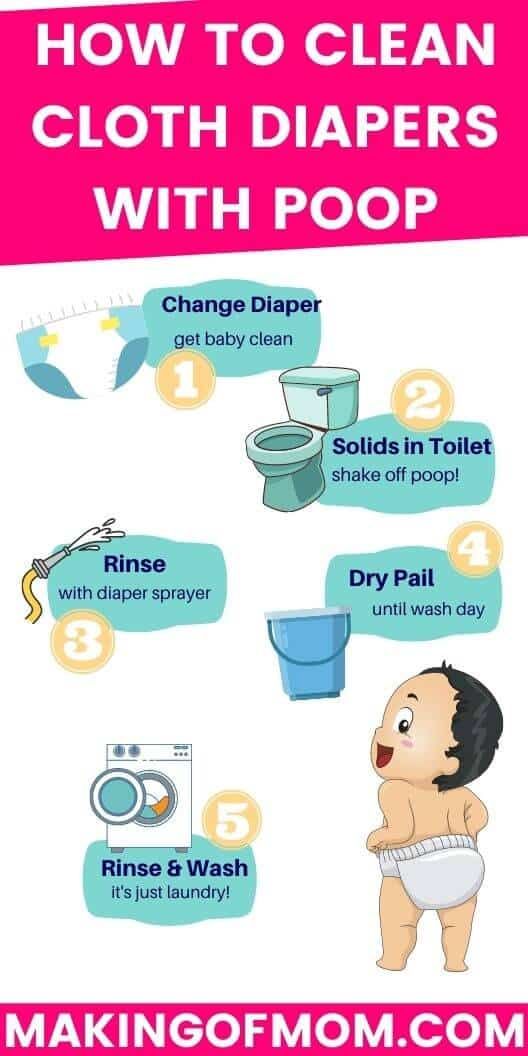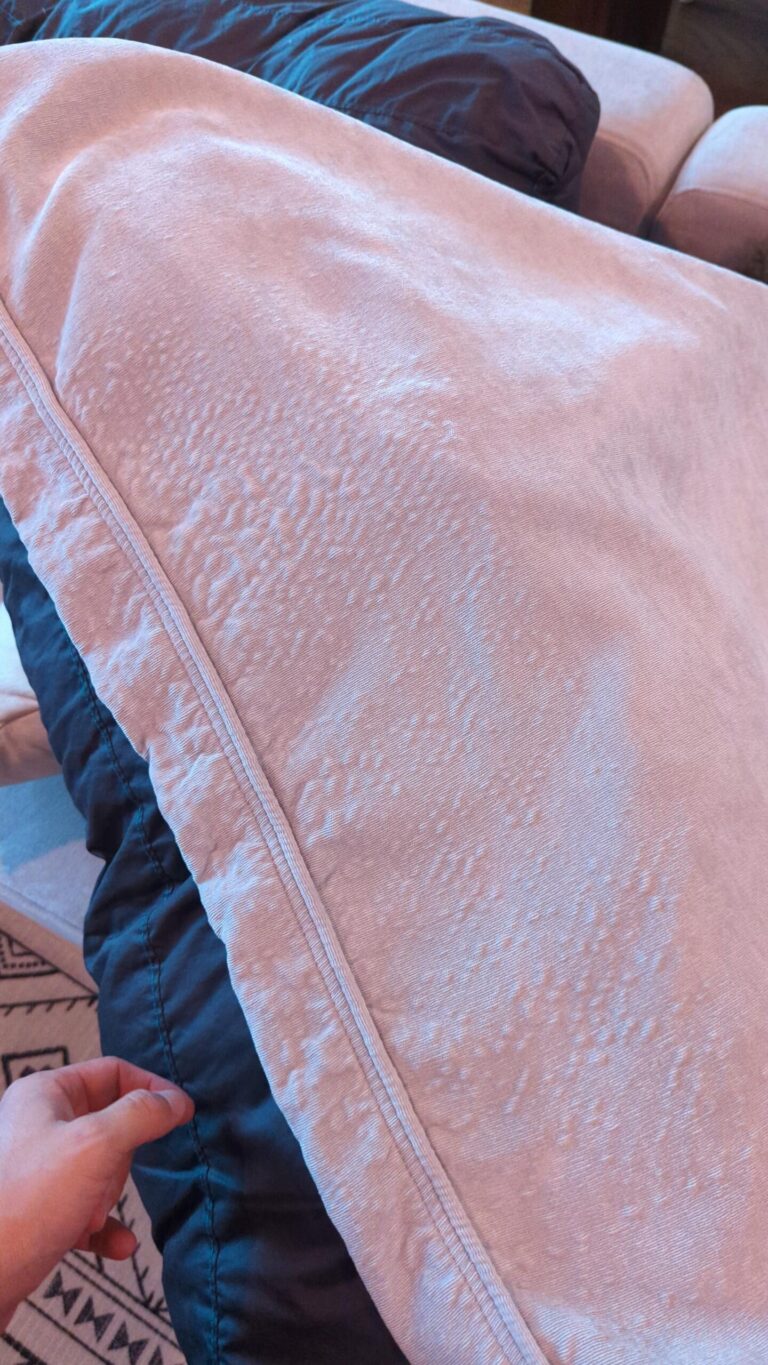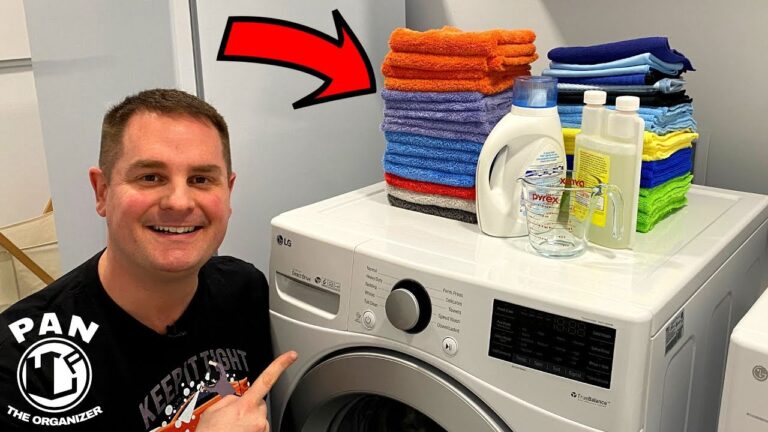How to Wash Cloth Diapers With Poop: A Step-by-Step Guide
To wash cloth diapers with poop, first remove as much solid waste as possible, then proceed to a pre-wash cycle. Next, run a regular wash cycle with a small amount of detergent.
Washing cloth diapers doesn’t have to be a daunting task. With the right approach, you can keep your baby’s cloth diapers clean and fresh, ensuring they’re always ready for use. Dealing with poop is a common concern for parents opting for cloth diapers over disposables.
The key lies in tackling the issue head-on with a straightforward cleaning routine. By removing solids before the wash and choosing the appropriate wash cycle, you can effectively clean the diapers. This method not only helps in maintaining the diapers in good condition but also contributes to a more sustainable parenting approach. Remember, the goal is to make the process as efficient and hygienic as possible, ensuring the diapers remain comfortable and safe for your baby’s use.
Introduction To Cloth Diapers
Welcome to the eco-friendly world of cloth diapers! As more families strive for sustainability, understanding the basics of cloth diapering is key. This guide will navigate the benefits and concerns, ensuring your little one stays clean and comfortable.
Popularity And Benefits
Cloth diapers have gained popularity due to their environmental perks and cost-effectiveness. They come in various styles, colors, and materials, catering to different needs and preferences. Let’s delve into the advantages:
- Eco-friendly: Reduces landfill waste.
- Reusable: Saves money over time.
- Gentle on skin: Fewer chemicals than disposables.
- Adjustable fit: Grows with your baby.
Common Concerns
Parents often worry about cleaning diapers with poop. It may seem daunting, but with the right approach, it’s manageable. Here are some common concerns:
- Stain removal effectiveness.
- Sanitization and hygiene.
- Handling and storing soiled diapers.
Stay tuned for our step-by-step guide on washing cloth diapers with ease and confidence!

Credit: dirtydiaperlaundry.com
Types Of Cloth Diapers
Understanding the types of cloth diapers is key to effective washing. Each type has unique features. Proper care keeps them absorbent and comfortable for your baby.
Prefolds And Flats
Prefolds are rectangular and have multiple layers. The center has the most layers for absorbency. Flats are single-layered and can be folded in various ways. Both are versatile and economical.
- Easy to clean and dry
- Customizable fit
- Durable over time
Fitteds And Pockets
Fitteds hug your baby’s shape. They have elastic edges for a snug fit. Pockets have a waterproof exterior. They feature a pocket for absorbent inserts.
| Fitteds | Pockets |
|---|---|
| Contoured fit | Customizable absorbency |
| Elastic legs and waist | Stay-dry lining |
All-in-ones And Hybrids
All-in-Ones (AIOs) are the most like disposable diapers. They are one piece with sewn-in absorbency. Hybrids combine cloth and disposable elements. They offer convenience and flexibility.
- No stuffing or folding required
- Great for on-the-go families
- Hybrids allow for disposable inserts
Before You Start: Preparation Tips
Washing cloth diapers with poop can seem daunting at first. Yet, with the right preparation, it becomes a breeze. Before diving into the cleaning process, it’s crucial to have everything ready. This ensures a smooth and efficient workflow. Let’s explore some essential preparation tips.
Gathering Supplies
Having all necessary items on hand makes the task easier. Ensure you have:
- Gloves to keep your hands clean.
- A diaper sprayer or bucket for rinsing.
- Detergent that’s safe for cloth diapers.
- A wet bag or pail liner for dirty diapers.
Gather these supplies before starting. This avoids any mid-process hiccups.
Setting Up A Diapering Area
A dedicated diapering area streamlines the process. This area should have:
- A changing table or clean surface.
- Easy access to your supplies.
- A trash can or wet bag for disposables.
Ensure the area is well-lit and comfortable for both you and your baby. This creates a calm environment for diaper changes.
Initial Removal Of Waste
Initial Removal of Waste is a key step in washing cloth diapers with poop. This step ensures that the rest of the cleaning process is smoother and more effective. Let’s dive into the best methods to get rid of the solids.
Shaking Solids Into The Toilet
- Hold the diaper over the toilet.
- Gently shake to let the poop fall into the toilet.
- For stubborn waste, flex the diaper back and forth.
- Flush the toilet to dispose of the waste.
This method is simple and effective. It requires no extra tools.
Using A Diaper Sprayer
- Attach the sprayer to your toilet’s water supply.
- Hold the diaper inside the toilet bowl.
- Use the sprayer to wash away the poop.
- Adjust the pressure as needed for stubborn waste.
- Flush the toilet to dispose of the waste.
A diaper sprayer makes removing waste quick and hygienic.
Pre-wash Rinsing Techniques
Dealing with diaper duty means handling the mess efficiently. Pre-wash rinsing removes the bulk of waste, preventing stains and odors. This step is vital for clean, fresh cloth diapers. Discover the best pre-wash rinsing methods below.
Cold Water Rinse
Cold water is the first line of defense against diaper stains. It prevents poop from setting into the fabric. Here’s how to execute a cold water rinse:
- Remove the diaper and dispose of solid waste in the toilet.
- Rinse the diaper under cold running water.
- Use a spray attachment for targeted cleaning.
- Wring out excess water before the main wash cycle.
Soaking Methods
Soaking helps break down waste, easing the wash process. Follow these simple soaking steps:
- Fill a pail or tub with cold water.
- Add a small amount of detergent designed for diapers.
- Submerge the diapers for 30 minutes to an hour.
- Drain and squeeze out the water gently.
Remember, never soak diapers for too long to avoid fabric damage.
Washing Cloth Diapers
Clean diapers ensure a happy baby and a happy planet. Proper washing removes waste and prevents skin irritation. Master the art of cleaning cloth diapers with these steps.
Choosing The Right Detergent
Select a detergent free from fragrances, dyes, and enzymes. These can irritate baby skin. Look for products labeled “cloth diaper safe.”
- Check ingredients – Avoid softeners and bleach.
- Consider the baby’s skin – Pick hypoallergenic options for sensitive skin.
- Read reviews – Other parents’ experiences guide you.
Machine Wash Settings
Adjust your washer settings for optimal cleaning. Use a pre-wash cycle to rinse away waste. Follow with a heavy-duty wash cycle.
| Step | Action |
|---|---|
| 1 | Pre-rinse with cold water |
| 2 | Wash with hot water |
| 3 | Extra rinse to remove residue |
Hand Washing Methods
Hand washing can be effective and economical. Use a clean basin or tub. Fill with hot water and add detergent.
- Submerge diapers – Soak for a few minutes.
- Scrub gently – Use a brush on soiled areas.
- Rinse thoroughly – Repeat until water runs clear.
Wring out excess water before drying. Sunlight helps remove stains and disinfect naturally.
Post-wash Care
Once you’ve tackled the challenge of washing cloth diapers with poop, the next crucial steps are all about post-wash care. Proper drying, sun bleaching, and storage not only maintain the diaper’s quality but also ensure your baby’s comfort. Let’s explore how to give your clean diapers the best after-wash treatment.
Drying Options
Drying cloth diapers correctly preserves their shape and absorbency. You have two main options:
- Air drying: Hang diapers on a line or drying rack. This method is gentle and energy-efficient.
- Tumble drying: Use a dryer on a low or medium heat setting. Check the diaper’s care label first.
Sun Bleaching
Sunlight is a natural bleach and disinfectant. It helps remove any remaining stains and odors. Lay diapers out in direct sunlight for a few hours. Make sure they are completely dry before storing.
Storing Clean Diapers
Storage is key to keeping diapers ready for use. Follow these tips:
- Store in a cool, dry place.
- Avoid airtight containers, as they can promote mildew.
- Use a breathable fabric bag or a shelf in your baby’s closet.

Credit: www.conejocommunityoutreach.com
Troubleshooting Common Issues
Tackling cloth diaper issues ensures your baby stays comfortable. This guide solves common problems with ease.
Dealing With Stains
Stains can be persistent. Pre-treatment is key. Use a stain remover designed for babies.
- Sunlight naturally bleaches out stains.
- Apply lemon juice before sun drying for tough spots.
- For stubborn stains, create a paste with baking soda and water.
- Allow the paste to sit before washing.
Odor Management
Diapers should smell fresh post-wash. If not, odor issues may arise.
- Rinse diapers soon after use.
- Use a diaper pail with proper ventilation.
- Add vinegar to the rinse cycle for a natural odor eliminator.
- Regular washes prevent odor buildup.
Diaper Stripping
Diaper stripping removes buildup. Perform every few months or when issues persist.
| Step | Action |
|---|---|
| 1 | Wash diapers clean of waste. |
| 2 | Soak in hot water with a diaper stripper. |
| 3 | Rinse thoroughly until water runs clear. |
Health And Hygiene
Caring for your baby’s cloth diapers is vital. It helps prevent rashes and infections. A proper wash routine keeps diapers clean and safe. This section covers how to manage cloth diapers with poop.
Skin Sensitivities
Babies’ skin is delicate. It reacts to harsh chemicals. Use gentle, fragrance-free detergents. This prevents irritation and discomfort. Follow these steps:
- Choose a hypoallergenic detergent
- Rinse diapers in warm water first
- Do a second wash with the chosen detergent
- Rinse thoroughly to remove all soap
Ensuring Sanitary Conditions
Keeping diapers free from harmful bacteria is crucial. A good wash routine does this. It protects your baby’s health. Here’s how to ensure cleanliness:
- Remove solids into the toilet
- Rinse diapers under hot water
- Wash in a hot cycle with a full water level
- Use a sanitizing cycle if available
Remember to dry diapers completely. Sunlight naturally bleaches and disinfects. Always check the manufacturer’s guidelines.

Credit: nestandsprout.ca
Eco-friendly Disposal Of Diaper Waste
Parents today seek green solutions for baby care. Diaper disposal is no exception. Proper handling of diaper waste is crucial. It protects the environment and supports sustainability.
Composting Diaper Liners
Compostable diaper liners offer a solution. They break down in proper composting conditions. This method reduces landfill waste. Ensure liners are truly compostable before attempting this.
- Check the packaging for composting certifications.
- Use a separate bin for diaper composting.
- Consult local compost facilities for guidelines.
Remember, only compost urine-soaked liners at home. Poop requires special handling. Compost it at industrial facilities.
Sustainable Practices
Adopting sustainable methods is key. Reducing diaper waste helps our planet. Here are practices to follow:
| Practice | Benefit |
|---|---|
| Use cloth diapers | Lowers disposable diaper use |
| Biodegradable liners | Eases clean-up, lessens plastic use |
| Proper wash routine | Extends diaper life, reduces waste |
Wash cloth diapers correctly. Use eco-friendly detergents. Dry in the sun when possible. These steps maintain diaper quality. They also cut down on energy consumption.
Cost Analysis
Let’s dive into the cost analysis of washing cloth diapers. Many parents choose cloth diapers for their babies. They think about how much money they can save. We will look at the savings and long-term benefits.
Savings Compared To Disposables
Choosing cloth diapers over disposables saves a lot of money. Here is why:
- Initial cost: Cloth diapers cost more at first. But, you buy them less often.
- Use many times: You wash and reuse cloth diapers. This means you buy fewer diapers over time.
- Less waste: Fewer diapers in the trash saves you disposal fees.
A table shows the average savings:
| Diaper Type | Cost Over 2 Years |
|---|---|
| Disposable | $1400 |
| Cloth | $600 |
This table shows cloth diapers save you $800 over 2 years.
Long-term Benefits
Using cloth diapers has more benefits than just saving money. Here are some:
- Better for the environment: Cloth diapers make less trash.
- Good for baby’s skin: They are gentle and cause fewer rashes.
- Can use for next baby: Save them for your next child and save even more.
These benefits make cloth diapers a smart choice for the future.
Frequently Asked Questions
Can Vinegar Sanitize Cloth Diapers Effectively?
Vinegar can be used as a natural disinfectant for cloth diapers. Adding a half-cup to the rinse cycle can help remove odors and residue. However, consult the diaper’s care label as vinegar may not be suitable for all fabrics.
How Often Should You Wash Cloth Diapers With Poop?
Wash cloth diapers with poop at least every two days. Frequent washing prevents stains from setting and controls odor. For hygiene, never let soiled diapers sit for too long before laundering them.
What Temperature Is Best For Washing Poopy Cloth Diapers?
Hot water is best for washing poopy cloth diapers. It helps to sanitize the fabric and dissolve solids. Typically, a water temperature of around 130°F (55°C) is recommended for effectively cleaning diapers.
Is It Necessary To Rinse Cloth Diapers Before Washing?
Yes, it’s necessary to rinse cloth diapers before washing. Rinsing removes most of the poop, which helps to prevent staining and odors. A prewash rinse can be done manually or with a diaper sprayer.
Conclusion
Washing cloth diapers doesn’t have to be daunting. By following the straightforward steps outlined above, you can ensure your baby’s diapers remain clean and fresh. Remember, consistency is key for the best results. Embrace the process, and you’ll master the art of cleaning cloth diapers in no time.
Keep your little one comfy and your conscience clear with eco-friendly diapering!






